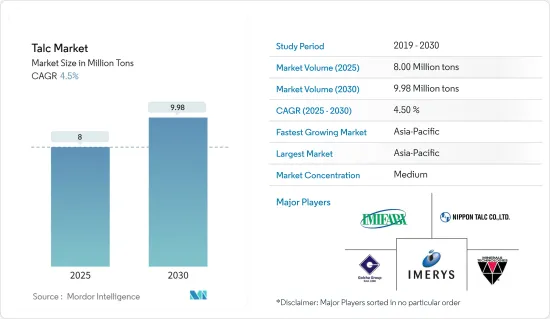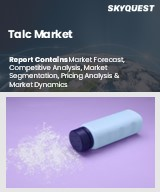
|
시장보고서
상품코드
1685759
세계의 탈크 시장 : 점유율 분석, 산업 동향 및 통계, 성장 예측(2025-2030년)Talc - Market Share Analysis, Industry Trends & Statistics, Growth Forecasts (2025 - 2030) |
||||||
세계의 탈크 시장 규모는 2025년 800만 톤으로 추계되며, 예측 기간 중(2025-2030년) CAGR 4.5%로 확대되어, 2030년에는 998만 톤에 달할 것으로 예측됩니다.

COVID-19 팬데믹은 지난 수년간 세계 규모로 시장에 영향을 주었고, 세라믹 제조업체, 펄프 및 제지 제조업체, 페인트 및 코팅 제조업체에 조업 정지를 강요시켜, 2022년 탈크 수요를 저하시켰습니다.
주요 하이라이트
- 단기적으로는 공업용 및 선박용 코팅제 수요 증가가 탈크 수요를 견인하고 있습니다.
- 그 반면, 탈크 베이스의 화장품에 관한 건강 문제가 시장의 성장을 방해할 것으로 예상됩니다.
- 항공우주 산업에서 열가소성 플라스틱 수요 증가는 미래에 기회로 작용할 가능성이 높습니다.
- 아시아태평양은 중국 플라스틱 시장의 발흥과 인도와 같은 국가의 화이트 탈크 매장량의 존재에 의해 탈크 시장을 세계적으로 지배했습니다.
탈크 시장 동향
플라스틱 및 고무 산업이 시장을 독점
- 탈크는 폴리프로필렌에 높은 강성이나 치수 안정성의 향상 등 다양한 이점을 가져옵니다.
- 주로 플라스틱의 충전재로서 사용되어 제조시에는 흡수제나 고결 방지제로서 작용합니다.
- 탈크는 화학, 플라스틱, 고무 등 다양한 산업에서 가장 일반적으로 사용되는 첨가제, 개질제, 충전제입니다.
- Plastics Europe에 따르면 유럽의 플라스틱 수요의 약 3분의 2는 독일 25.4%, 이탈리아 14.3%, 프랑스 9.7%, 영국 7.6%, 스페인 7.5%의 5개국에 집중되고 있습니다.
- 유럽 플라스틱 시장에서 사업을 전개하는 대기업은 지리적 존재를 확대하기 위해 전략적 시장 개척에 기울고 있습니다. 2022년 6월, Linde Engineering는 Slovnaft로 선정되어 슬로바키아의 폴리프로필렌 공장의 개수를 실시했습니다.
- 2022년 12월, Exxon Mobil Corporation은 루이지애나의 주도 배턴 루지에서 폴리프로필렌의 새로운 제조 설비를 가동시켰습니다.
- 전자상거래 산업이 포장을 필요로 하기 때문에 인도네시아에서 플라스틱 사용량이 증가하고 있습니다. Wilmar 그룹, Mayora 및 Indofood를 포함한 FMCG 기업은 인도네시아에 통합 패키징 생산 단위를 설립했습니다. Exxon Mobil도 인도네시아의 플라스틱 산업에 투자하고 있습니다. Exxon Mobil은 2022년 11월 PT Indomobil Prima Energi(IPE)와 인도네시아의 고급 플라스틱 재활용 기술의 대규모 응용에 관한 각서에 서명했습니다.
- 그러므로 업계의 다양한 기업이 수행하는 이러한 확장 프로젝트는 예측 기간 동안 시장 성장을 가속할 것으로 보입니다.
시장을 독점하는 아시아태평양
- 아시아태평양은 중국, 인도, 일본 등 국가 수요 증가로 세계 시장 점유율을 독점하고 있습니다.
- 중국은 아시아태평양에서 활석의 주요 소비자 중 하나입니다. 이 나라는 세라믹, 음식, 펄프, 제지 등 폭넓은 산업에서 활석을 사용하고 있습니다. 산업정보화성의 데이터에 따르면 이 나라의 음료 생산량은 전년 동기 대비 6% 증가했으며 2023년 1분기에 4,435만 톤에 달했습니다.
- 또한 중국은 세계 최대 수준의 세라믹 생산국이며 소비국이기도 합니다. 세계 최대의 세라믹 타일 생산국 중 하나이며 약 84억 7,000만 평방미터의 세라믹 타일을 생산하고 있습니다. 국내 시장 및 수출 시장에서 치열한 경쟁은 세라믹 제조 업체에게 생산 공정과 제품의 품질 향상을 강력하게 합니다.
- 인도는 백색 활석 매장량이 있는 몇 안되는 국가 중 하나입니다. 활석의 광상은 국가에서 발견됩니다. 생산된 화이트 탈크의 대부분은 국내에서 소비됩니다.
- 인도에서는 탈크의 상업 생산의 대부분이 라자스탄 주에서 이루어지고 있습니다.
- 인도의 플라스틱 산업 시장은 이 나라에서 가장 중요한 경제 부문 중 하나입니다.
- 게다가 중국에는 기능하기 위해 대량의 탈크 공급을 필요로 하는 거대한 플라스틱 시장이 있습니다.
- 이러한 모든 요인이 예측기간 동안 이 지역의 탈크 수요를 촉진할 것으로 예상됩니다.
탈크 산업 개요
탈크 시장은 세계 수준 및 지역 수준에서도 여러 기업이 활동하고 있으며, 그 성격상 적당히 통합되어 있습니다.
기타 혜택:
- 엑셀 형식 시장 예측(ME) 시트
- 3개월의 애널리스트·지원
목차
제1장 서론
- 조사의 전제조건
- 조사 범위
제2장 조사 방법
제3장 주요 요약
제4장 시장 역학
- 성장 촉진요인
- 플라스틱 수요 증가
- 공업용 및 선박용 코팅제 수요 증가
- 억제요인
- 화장품의 건강 문제
- 업계 밸류체인 분석
- Porter's Five Forces 분석
- 공급기업의 협상력
- 소비자의 협상력
- 신규 참가업체의 위협
- 대체품의 위협
- 경쟁도
제5장 시장 세분화
- 보증금
- 탈크 클로라이트
- 탈크 카보네이트
- 최종 사용자 산업
- 세라믹
- 식음료
- 페인트
- 퍼스널케어
- 플라스틱 및 고무
- 펄프 및 종이
- 기타 최종 사용자 산업
- 지역
- 아시아태평양
- 중국
- 인도
- 일본
- 한국
- 기타 아시아태평양
- 북미
- 미국
- 캐나다
- 멕시코
- 유럽
- 독일
- 영국
- 프랑스
- 이탈리아
- 스페인
- 기타 유럽
- 남미
- 브라질
- 아르헨티나
- 기타 남미
- 중동 및 아프리카
- 사우디아라비아
- 남아프리카
- 기타 중동 및 아프리카
- 아시아태평양
제6장 경쟁 구도
- M&A, 합작사업, 제휴, 협정
- 시장 점유율(%)**/랭킹 분석
- 주요 기업의 전략
- 기업 프로파일
- AKJ MinChem
- ANAND TALC
- Chanda Minerals
- ELEMENTIS PLC
- Eurominerals Gmbh
- Golcha Group
- Imerys
- IMI Fabi SpA
- LITHOS Industrial Minerals GmbH
- Magris Performance Materials
- Minerals Technologies Inc.
- Nippon Talc Co. Ltd
제7장 시장 기회와 앞으로의 동향
- 항공우주 산업에서 열가소성 플라스틱 수요 증가
The Talc Market size is estimated at 8.00 million tons in 2025, and is expected to reach 9.98 million tons by 2030, at a CAGR of 4.5% during the forecast period (2025-2030).

The COVID-19 pandemic affected the market in the past years on a global scale and forced ceramic makers, pulp and paper manufacturers, and paints and coatings manufacturers to shut down their operations, lowering the demand for talc in 2022. However, the condition is expected to recover, which will restore the growth trajectory of the market studied during the latter half of the forecast period.
Key Highlights
- Over the short term, increasing demand for industrial and marine coatings is driving the demand for talc, as it provides benefits such as corrosion protection, solvent reduction, and good adhesion.
- On the flip side, health issues pertaining to talc-based cosmetic products are expected to hamper the market's growth.
- The growing demand for thermoplastics in the aerospace industry is likely to act as an opportunity in the future.
- Asia-Pacific dominated the talc market globally, owing to the rising plastics market in China and the presence of white talc reserves in countries like India.
Talc Market Trends
Plastic and Rubber Industry to Dominate the Market
- Talc imparts a variety of benefits to polypropylene, such as higher stiffness and improved dimensional stability.
- It is mainly used as a filler in plastics and acts as an absorbent and anti-caking agent during production. The plate shape of talc particles increases the hardness of products such as polyethylene, polypropylene, nylon, vinyl, and polyester. It also increases heat resistance and reduces shrinkage.
- Talc is the most commonly used additive, modifier, or filler in a variety of industries, including chemicals, plastics, and rubber. It can significantly improve the tensile strength of plastic products, impact properties, heat resistance, creep resistance, tear resistance, etc.
- According to Plastics Europe, about two-thirds of Europe's plastics demand is concentrated in five countries, including 25.4% in Germany, 14.3% in Italy, 9.7% in France, 7.6% in the United Kingdom, and 7.5% in Spain, according to Plastics Europe.
- The major companies operating in the European plastic market are more inclined towards strategic business development to expand their geographical presence. For instance, in June 2022, Linde Engineering was selected by Slovnaft - a member company of MOL Group, to conduct a revamp of a polypropylene plant in Slovakia. This revamped the plant capacity of polypropylene per year by 18% to around 300 kilotons, and the storage facility expanded from 45 to 61 silos.
- In December 2022, Exxon Mobil Corporation started a new manufacturing facility for polypropylene in Baton Rouge, the capital of Louisiana. This plant can produce 450,000 MT/year of polypropylene. Further, Formosa Plastics Corporation, in the United States, is constructing a new manufacturing facility for polypropylene in Point Comfort, Texas in the United States. Upon completion in 2024, this plant will produce 100,000 tonnes of Alpha olefins to manufacture high-density polyethylene (HDPE). 63,000 tonnes of Alpha olefins would be used by the company while the remaining 37,000 tonnes would be sold internationally.
- The usage of plastic in Indonesia is increasing since the e-commerce industry requires packaging. FMCG companies, including Wilmar Group, Mayora, and Indofood, have established integrated packaging production units in Indonesia. Exxon Mobil is also investing in the Indonesian plastic industry. It signed a memorandum of understanding with PT Indomobil Prima Energi (IPE), in November 2022, regarding the application of advanced plastic recycling technology on a large scale in Indonesia.
- Hence, such expansion projects carried out by various companies in the industry are likely to drive the market growth during the forecast period.
Asia-Pacific Region to Dominate the Market
- The Asia-Pacific region dominated the global market share with the growing demand from the countries such as China, India, and Japan.
- China is one of the major consumers of talc in the Asia-Pacific region. The country uses talc in a wide range of industries, such as ceramics, food and beverage, pulp and paper, and others. According to the data from the Ministry of Industry and Information Technology, the country witnessed increase in its beverage production by 6 percent year-on-year, reaching 44.35 million tons during Q1 2023.
- Also, China is the leading producer and consumer of ceramics worldwide. It is one of the largest producers of ceramic tiles in the world and has produced around 8.47 billion square meters of ceramic tiles. The fierce competition in the domestic and export markets forces ceramic producers to improve their production process and product quality in the region.
- India is one of the few countries with white talc reserves. The deposits of talc are found throughout the country. Most of the white talc produced is consumed in the country itself.
- In India, most of the commercial production of talc comes from Rajasthan. The two leading talc producers in the country (Golcha Group and Golcha Associated) are based in Jaipur, Rajasthan, catering cosmetics and polymer industry with talc of superior grades.
- The Indian plastic industry market is one of the country's most important economic sectors. According to the India Brand Equity Foundation, the total value of plastics exported between April and September 2022 was USD 6.38 billion.
- Furthermore, China has a huge plastics market that requires a high supply of talc to function. In China, talc is found in 15 provinces, with Liaoning, Shandong, Guangxi, Jiangxi, and Qinghai as the prominent areas that account for more than 90% of the total reserves.
- All these factors, in turn, are expected to drive the demand for talc in the region during the forecast period.
Talc Industry Overview
The talc market is moderately consolidated in nature, with several companies operating on both global and regional levels. Some of the major players in the market (not in any particular order) include ELEMENTIS PLC, Imerys, IMI Fabi SpA, Nippon Talc Co. Ltd, and Minerals Technologies Inc.
Additional Benefits:
- The market estimate (ME) sheet in Excel format
- 3 months of analyst support
TABLE OF CONTENTS
1 INTRODUCTION
- 1.1 Study Assumptions
- 1.2 Scope of the Study
2 RESEARCH METHODOLOGY
3 EXECUTIVE SUMMARY
4 MARKET DYNAMICS
- 4.1 Drivers
- 4.1.1 Increasing Demand for Plastics
- 4.1.2 Increasing Demand for Industrial and Marine Coatings
- 4.2 Restraints
- 4.2.1 Health Issues in Cosmetic Products
- 4.3 Industry Value Chain Analysis
- 4.4 Porter's Five Forces Analysis
- 4.4.1 Bargaining Power of Suppliers
- 4.4.2 Bargaining Power of Consumers
- 4.4.3 Threat of New Entrants
- 4.4.4 Threat of Substitute Products and Services
- 4.4.5 Degree of Competition
5 MARKET SEGMENTATION (Market Size in Volume)
- 5.1 Deposit
- 5.1.1 Talc Chlorite
- 5.1.2 Talc Carbonate
- 5.2 End-user Industry
- 5.2.1 Ceramic
- 5.2.2 Food and Beverage
- 5.2.3 Paints and Coatings
- 5.2.4 Personal Care
- 5.2.5 Plastics and Rubber
- 5.2.6 Pulp and Paper
- 5.2.7 Other End-user Industries
- 5.3 Geography
- 5.3.1 Asia-Pacific
- 5.3.1.1 China
- 5.3.1.2 India
- 5.3.1.3 Japan
- 5.3.1.4 South Korea
- 5.3.1.5 Rest of Asia-Pacific
- 5.3.2 North America
- 5.3.2.1 United States
- 5.3.2.2 Canada
- 5.3.2.3 Mexico
- 5.3.3 Europe
- 5.3.3.1 Germany
- 5.3.3.2 United Kingdom
- 5.3.3.3 France
- 5.3.3.4 Italy
- 5.3.3.5 Spain
- 5.3.3.6 Rest of Europe
- 5.3.4 South America
- 5.3.4.1 Brazil
- 5.3.4.2 Argentina
- 5.3.4.3 Rest of South America
- 5.3.5 Middle-East and Africa
- 5.3.5.1 Saudi Arabia
- 5.3.5.2 South Africa
- 5.3.5.3 Rest of Middle-East and Africa
- 5.3.1 Asia-Pacific
6 COMPETITIVE LANDSCAPE
- 6.1 Mergers and Acquisitions, Joint Ventures, Collaborations, and Agreements
- 6.2 Market Share(%)**/Ranking Analysis
- 6.3 Strategies Adopted by Leading Players
- 6.4 Company Profiles
- 6.4.1 AKJ MinChem
- 6.4.2 ANAND TALC
- 6.4.3 Chanda Minerals
- 6.4.4 ELEMENTIS PLC
- 6.4.5 Eurominerals Gmbh
- 6.4.6 Golcha Group
- 6.4.7 Imerys
- 6.4.8 IMI Fabi SpA
- 6.4.9 LITHOS Industrial Minerals GmbH
- 6.4.10 Magris Performance Materials
- 6.4.11 Minerals Technologies Inc.
- 6.4.12 Nippon Talc Co. Ltd
7 MARKET OPPORTUNITIES AND FUTURE TRENDS
- 7.1 Growing Demand for Thermoplastics in the Aerospace Industry



















